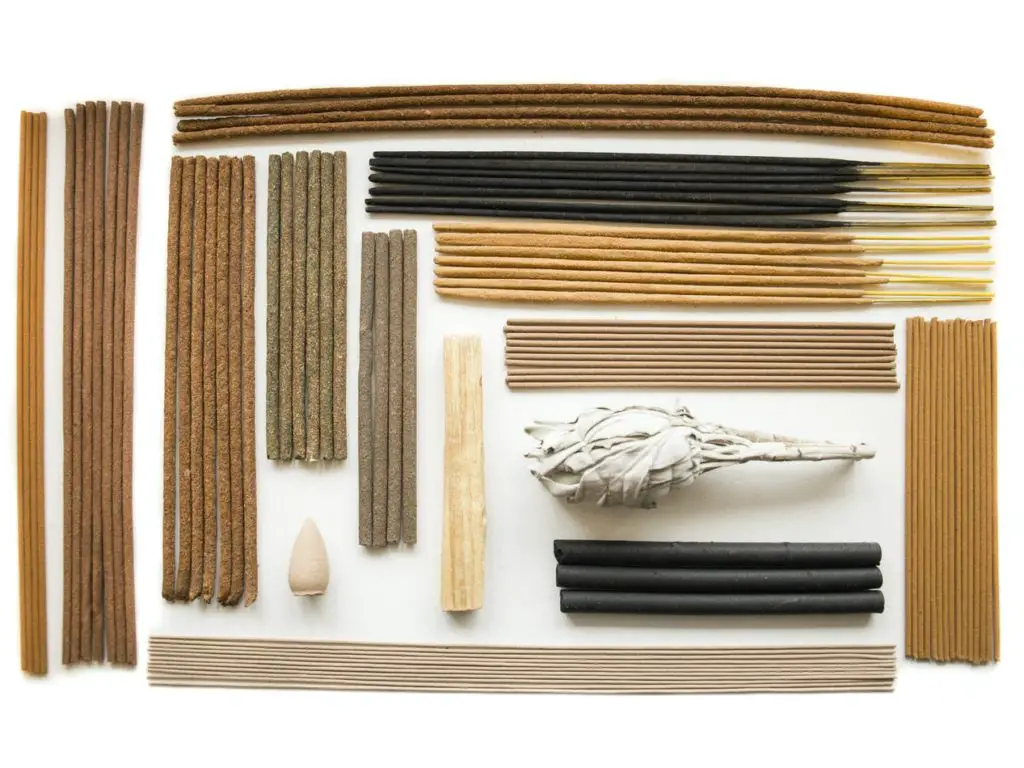One of the best ways of making a home smell good and create a soothing vibe to relax after a long, tiring day is using incense. The fragrant smoke slowly drifts around your entire house, filling every nook and corner with an essence of peace, tranquility, and meaning. Just watching the heavy smoke of a backflow burner can bring about an aura of calm, with the scent further improving your mood and getting rid of all the exhaustion.
The most common formats for incense are incense sticks and incense cones, along with resins and other assorted uncommon formats. Which is best? In this article, we’ll look at Incense Cones Vs Sticks, and discuss the pros and cons of each of these incense types.
To Burn

The word ‘incense’ itself is derived from a Latin word translated to ‘burn.’ This material has been used by ancient folk since early times, especially in religious rituals of the Egyptians, Greek, and Babylonian empires.
It has deep meaning over the centuries, including:
- A way to counteract any unpleasant smells.
- Means of repelling demons or other evil entities.
- Part of religious practices and worship.
- To help clear the mind during yoga and meditation.
Incense is typically made of a mixture of natural aromatic ingredients and frequently an artificial combustible base material to hold them in shape. (some are more natural than others).
Incense Cones vs. Sticks
We will start our comparison by first looking at the features of the cones and sticks. In this section, you will also find some of the best-rated incense cones and sticks to buy.
Features of Traditional Incense Cones
Incense cones offer a strong, aromatic fragrance that can enhance the scent of any room. They are commonly used in general yoga practices or during meditative sessions to create a relaxing atmosphere.
Cone incense is made of three materials:
- Aromatic plant-based powders.
- A botanical gum/ demulcent
- Water
The gum or demulcent works to glue the powders together, forming the cone shape. These are usually cheaper than the sticks and easier to manufacture.
They typically come in a lesser variety of scents, but if you get a backflow incense cone and a waterfall burner, you can get this:

Steps for Burning an Incense Cone
Using an incense cone is quite different from burning a stick. Here is how to do it. Note that if you get backflow cones (cones with a hole drilled in them), they will only produce the gravity-defying effect if you burn them in a waterfall burner.
Step 1
Select an incense burner large or vessel enough to hold your cone (always make sure the holder is made of a non-flammable material). Since cones come in various shapes and sizes, it is best to pick a holder with a slightly loose burner base and is bowl-shaped.
This will allow you to catch all the ash without it spreading into the room and creating a mess.
Step 2
Add a small amount of and or uncooked rice at the bottom of the burner in an even layer. This lets your cone lay on top of the burner to ensure an improved airflow without the burner getting too hot.
Remember to set the burner at a non-flammable surface without any table cloth or covers over it. Opt for a marble countertop or ceramic tile instead.
Step 3
Light the tip of your incense cone using a lighter or a match by exposing it to the flame for 10-15 seconds. Then, blow out the flame and fan it with a paper until you can see a wafting spiral of heavy, scented smoke releasing from the top of the cone.
Carefully place the incense cone into the burner and cover it with the lid. Enjoy the balmy scent that is soon to fill out your entire room! Leave a window or door open for ventilation to lessen the harms of breathing in the smoke, the potential for headache, etc.
Top Rated Incense Cones
Below, you will find a list of the five best incense cones found in the market, as per customer reviews.
Last update on 2025-06-27 / Affiliate links / Images from Amazon Product Advertising API
Features of Incense Sticks

Although many people consider incense sticks similar to cones, there are quite a few subtle differences to note. Incense manufacturers often craft only their best quality of Incense into sticks.
This automatically makes incense sticks more luxurious, offering a truly serene experience.
Incense sticks are frequently hand-rolled from an incense paste made of a mixture of herbs, spices, and other fragrant materials. This process allows the sticks to have a wider variety of scents available, which isn’t always possible in incense cones due to their pressed nature and particular consistency.
Steps for Burning an Incense Stick
You can’t use the same technique to burn incense cones and sticks. Here is an overview of how incense sticks should be burned for a long-lasting scent. Typically you want an incense tray or burner. But if you don’t have one, see our guide to burning incense sticks without a holder.
Step 1
Always try to get a cored incense stick. The wooden, bamboo core of these sticks is covered with incense material with the bottom few inches left uncovered. This feature makes it significantly easier to handle a burning incense. Moreover, it adds some wonderful earthy tones to the fragrance, making it so much better.
Step 2
Expose the very top of your incense stick to an open flame. Be careful not to put too much of the stick on fire; just the top is enough for a great scent without blackening the entire stick.
Step 3
The flaming part of the incense stick will start to release smoke and burn a bright red. This indicates it is smoldering well and will continue to burn steadily.
Step 4
Place the incense stick on an appropriately-sized incense holder or bowl to catch all the ash. Make sure your holder is non-flammable, as mentioned above.
Step 5
Place the holder containing the incense stick at least 2 meters away from you to directly prevent inhaling the concentrated smoke. Also, ensure the room is well ventilated with the windows opened. Enjoy the dream scent now, dancing around your room!
Top Rated Incense Sticks
Here, we have listed down the very best incense sticks according to raving customer reviews. Many of these are among the best brands of incense.
Last update on 2025-06-27 / Affiliate links / Images from Amazon Product Advertising API
Incense Cones vs Sticks
Incense cones are often considered the conically shaped cousins of incense sticks. However, they have a lot more differences than just being used differently. Here are some of the major ways that incense cones differ from incense sticks.
Scent Potency
In general, incense sticks are considered to be more potent than incense cones. This isn’t automatically true, and it’s certainly possible to find a cone that produces more scent than a stick, but usually, sticks are more heavily scented.
Burn Times
Since incense sticks just need to be shown the flame and catch fire immediately, their burn time is significantly lower than that of incense cones. On the other hand, the cones require the user to expose the top of the cone to an open flame for around 10 to 15 seconds before it is sufficiently lit.
Additionally, you will need to blow on it or fan it with a piece of paper for around 30 more seconds to avoid the cone from burning out immediately.
Lasting Time
People have commonly observed that when comparing incense cones vs. sticks, the former gets burned out much quicker than the latter. While a typical incense stick will last you a good 45-50 minutes, your incense cones will only last for 20 minutes or half an hour at maximum.
However, you should note that the incense cones give out a stronger and deeper fragrant smoke than the sticks.
Visual Dynamic
The ability for backflow cones to produce the gravity-defying waterfall of smoke makes them incredibly interesting to look at. Many find this visual experience soothing and compelling, especially for meditation and yoga practicioniers.
Scent Variety
Incense sticks are sold in a much wider variety of scents and blends. If you are looking for a particular scent, you’re more likely to find it in stick form than in cone form.
Storage
Although several research pieces have shown that both incense cones and sticks last for approximately the same amount of time, some users claim otherwise. Storage is often considered a key difference between the two, especially since people usually buy their Incense in bulk.
Many users have found that the different formulation of incense sticks allows them to last longer under proper storage conditions. On the other hand, the cones aren’t quite as long-lasting.
Other Forms of Incense Available
If you’re still unsure of the best possible choice for your incense needs, here are some other varieties of Incense available as well. People who can’t decide between incense cones vs. sticks should consider these unique forms:
- Loose Incense – requires a constant flame, charcoal, or an electric resin burner.
- Coil incense – Long burning time and appropriate for scenting large areas.
- Aromatic wood – pleasant atmosphere for special occasions.
- Kneaded Incense – blended, kneaded, and matured for three to five years for the Japanese Tea ceremony.
- Pressed Incense (in-Koh) – blended incense recipes filled into fancy molds.
- Incense in sachets – powdered or granulated Incense stuffed in a cloth pouch doesn’t require burning.
Frequently Asked Questions
We observed some confusion among people interested in using Incense for various purposes. In this section, we address some of the most frequently asked questions about incense cones vs. sticks so customers can use them safely.
Are Incense Cones Bad for You?
Incense is made of a mixture of natural and artificial ingredients to create different scents. These ingredients create tiny, inhalable particles released into the air as the cones or sticks burn. According to the United States Environmental Protection Agency, exposure to these particles can lead to asthma, lung inflammation, and other breathing problems.
The unnatural ingredients used to make Incense are also considered possible carcinogens. Long-term exposure to these is associated with a higher risk of developing upper respiratory cancer and squamous cell cancer.
They can set off smoke detectors, so burn them in a well-ventilated room, and keep your cat or dog away.
How Many Incense Sticks Should I Burn in a Day?
In general, people use anywhere between 2 to 5 sticks per day. It depends on how often you burn the sticks, how large the room is, and how long you wish for the scent to linger. Two sticks are sufficient for one session, but you can burn three if you wish to bathe in the scent.
Moreover, if you’re burning the sticks during an ordinary ritual like praying or meditation, one incense stick is sufficient.
Does Burning Incense Clean the Air?
There have been man studies conducted to determine if burning Incense can have an air-purifying effect. One of these studies showed that 1-hour long exposure of incense smoke to an indoor environment reduced the aerial bacteria population by 94%.
There was a massive decrease in the number of bacterial colonies, and the air remained purified for the next 24 hours, long after the Incense had been burned off.
Should You Open a Window When Burning Incense?
It is common to burn Incense in enclosed spaces with minimal ventilation, particularly when praying or meditating. While this is okay for short periods of time, if you’re a regular incense user, you should open the windows when burning the sticks or cones.
By increasing the ventilation area, you ensure there is a constant circulation of fresh air in the room. This helps in the cleansing and purifying of your indoor aerial space. Also, the opened windows reduce the chances of harmful artificial incense particles accumulating in your home.
Since these particles are possible carcinogens and carry a significant health risk, try to keep your windows open for some time even after the Incense has burned off.
Is Incense a Fire Hazard?
Anything that involves using an open flame is categorized as a fire hazard, and your incense cones or sticks are no different.
Incense sticks burn at really high temperatures and can do serious damage if they come in contact with any flammable material. They can also cause burn injuries and other problems if not handled carefully. When using Incense, always make sure the holder is non-flammable. Also, keep the burning Incense away from any curtain drapes, table covers, lampshades, etc.
Lastly, you should remember that the ashes from your incense stick can result in furniture discoloration. Try to protect your upholstery by using a spare dish under the holder to collect the ash, which can be disposed of once the Incense has completely burned off.
The Final Words
Both incense cones vs. sticks have their fair share of pros; the right choice solely depends on how you wish to scent up your room. If you want a variety of subtle scents that lasts for a long time, opt for a stick.
If you love the visual aspect of incense, cones and a backflow burner will be best for you.














